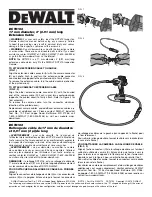
16
Tubing Cutters
(Figure 4) are more commonly utilized on
softer tubing such as copper, aluminium or even “soft” steel
tubing. If a tube cutter is utilized with stainless steel tubing,
remember that a special cutting wheel, designed for use with
stainless steel tubing should be employed. The use of dull
or improper cutting wheels can work harden the S.S. tubing
near the cut area. This CAN adversely affect the fittings
sealing ability.
Figure 5
Part Number: PT-C
Cutting with a Hacksaw
requires careful attention. It
is essential to use a guide to assure square cut offs. We
recommend our sawing vice (see Figure 5). Further, to
minimize the residual burrs, a hacksaw blade of 32 teeth per
inch minimum is suggested.
Sawing Vice Part Number: PT-V
Figure 6
Deburring the Tube End
The burrs formed by either the tube cutter or hacksaw must
be removed prior to assembly to prevent those burrs from
eventually damaging the system. O.D. burrs can prevent
tubing from seating properly in a fitting body. I.D. burrs can
restrict flow, as well as possibly break loose and damage fine
filtration elements.
Note: Do not over deburr the O.D. of tubing.
You may deburr the tubing with your choice of file(s) or utilize
Parker’s IN-EX De-burring tool. (Figure 6) This tool can be
used to deburr both the I.D. and O.D. of tubing sizes 1/8”
thru 1-1/2”.
IN-EX De-burring Tool Part Number: PT-D
Cleaning the Tube End
After you deburr the tubing, it is essential to remove burrs
from the tubing line. This can be accomplished by:
1. Flushing with solvent or low pressure compressed air.
2. Swab with lint-free cloth.
Again, this should prevent entrapping one of these small
burrs down-stream where it might do some system
damage.
Figure 4
Summary of Contents for Phastite PH-10-4N-TMS
Page 1: ...Phastite Tube Connectors Installation Manual BULLETIN 5909...
Page 33: ...41 42 Notes Notes...
Page 34: ......














































